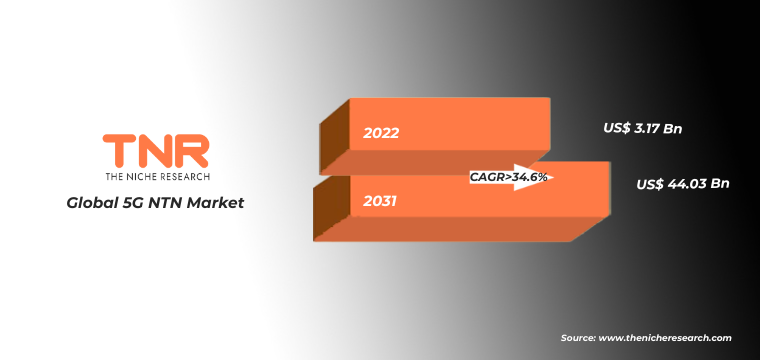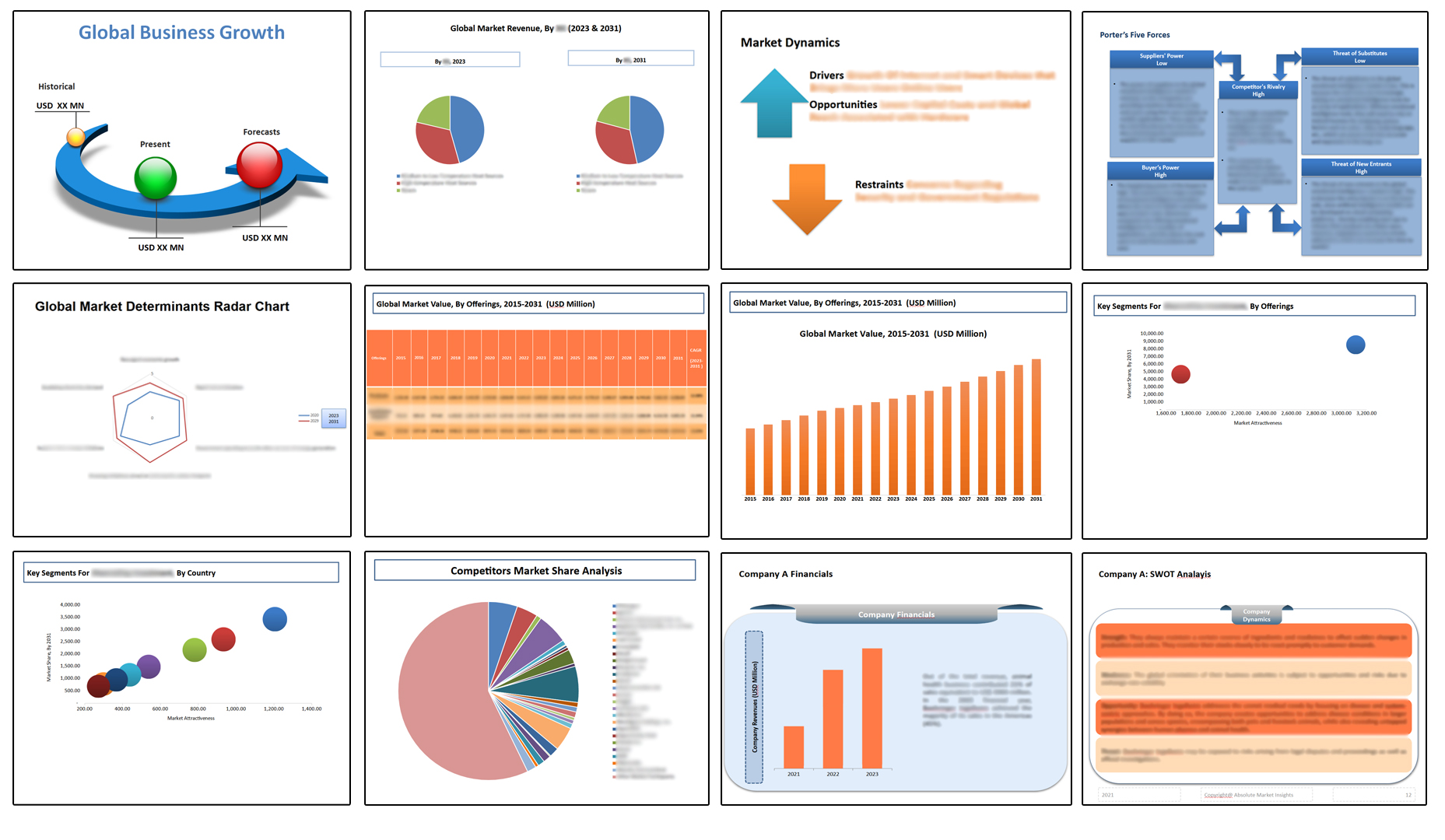Global 5G NTN Market By Component, By Platform, By Application, By Location, By End-Use Industry, By Region, Comparative Analysis, Trends and Forecasts, 2022 – 2031
- Industry: Technology
- Report ID: TNR-110-991
- Number of Pages: 420
- Table/Charts : Yes
- November, 2023
- Base Year : 2024
- No. of Companies : 9+
- No. of Countries : 29
- Views : 10155
- Covid Impact Covered: Yes
- War Impact Covered: Yes
- Formats : PDF, Excel, PPT
Global 5G NTN Market Accounted for US$ 3.17 Billion in 2022, Projected to Gain CAGR of 34.6% During 2023 – 2031
5G Non Terestrial Network (5G NTN) refers to the comprehensive overhaul of telecommunications infrastructure to enable fifth-generation (5G) wireless technology. It involves deploying new hardware, software, and protocols to enhance data speed, capacity, and latency. This transformation supports advanced applications like IoT, AR/VR, and autonomous vehicles, revolutionizing connectivity.
In the 5G NTN market, by platform, unmanned aerial systems (UAS) stand out as the dominating force in 2022. Their adaptability and versatility make them integral to the rapid deployment of 5G NTN infrastructure. UAS platforms excel in establishing temporary connectivity in remote or disaster-stricken areas, showcasing their crucial role.
Global 5G NTN Market Revenue & Forecast, (US$ Million), 2021 – 2031

COVID-19 Impact Analysis on Global 5G NTN Market
Prior to the pandemic, the 5G NTN market exhibited steady growth, driven by investments and network deployment for enhanced connectivity and emerging technologies like IoT. The pandemic accelerated the demand for robust and high-speed networks, prompting increased investments in 5G NTN. Remote work, telehealth, and digitalization surged, underscoring 5G’s role in enabling transformative solutions for a rapidly evolving world.
Report Coverage and Deliverables:

The rapid digitization across industries is a significant driver of the 5G NTN market. As businesses adopt IoT and data-driven processes, the demand for ultra-fast, low-latency connectivity escalates. A survey reported that industries like manufacturing, healthcare, and logistics expect to see a 20-50% reduction in downtime and 15-30% operational cost savings due to 5G-enabled IoT. This underscores how 5G NTN supports the digital transformation journey, enhancing efficiency and enabling new applications. A key restraint is the substantial investment required for 5G NTN infrastructure development.
Deploying new hardware, updating software, and building denser networks demand significant capital. A study found that US wireless carriers could invest over $100 billion in 5G infrastructure. This financial burden might hinder smaller players from participating actively, potentially leading to an uneven market landscape. Balancing the investment challenges with the potential benefits remains a critical consideration in the market’s growth trajectory.

The aerospace and defense sector is dominating the global 5G NTN market within the end-use industry category. With increasing emphasis on secure communication, real-time surveillance and autonomous systems, the Aerospace and Defense industry is integrating 5G to enhance situational awareness and operational efficiency. A study by Accenture revealed that 73% of defense organizations consider 5G crucial for their digital transformation strategy, solidifying its dominant role.

North America dominated the global 5G NTN market in 2022. The region’s early adoption of 5G technology, coupled with robust infrastructure investments, positions it as a leader. A GSMA report indicates that North America accounts for a significant share of global 5G connections, reflecting its dominance.
Competitive Landscape: Global 5G NTN Market:
- Anritsu
- EchoStar Corporation
- GILAT SATELLITE NETWORKS
- Keysight Technologies
- MediaTek Inc.
- Qualcomm Technologies, Inc.
- Rohde & Schwarz
- SES S.A.
- SoftBank Corp
- Thales Alenia Space
- Other Industry Participants
Global 5G NTN Market Report Coverage
| Report Specifications | Details |
| Market Revenue in 2022 | US$ 3.17 Billion |
| Market Size Forecast by 2031 | US$ 44.03 Billion |
| Growth Rate (CAGR) | 34.6% |
| Historic Data | 2021 |
| Base Year for Estimation | 2022 |
| Forecast Period | 2023 – 2031 |
| Report Inclusions | Market Size & Estimates, Market Dynamics, Competitive Scenario, Trends, Growth Factors, Market Determinants, Key Investment Segmentation, Product/Service/Solutions Benchmarking |
| Segments Covered | By Component, By Platform, By Application, By Location, By End-Use Industry |
| Regions Covered | North America, Europe, Asia Pacific, Middle East & Africa, Latin America |
| Countries Covered | U.S., Canada, Mexico, Rest of North America, France, The UK, Spain, Germany, Italy, Nordic Countries (Denmark, Finland, Iceland, Sweden, Norway), Benelux Union (Belgium, The Netherlands, Luxembourg), Rest of Europe, China, Japan, India, New Zealand, Australia, South Korea, Southeast Asia (Indonesia, Thailand, Malaysia, Singapore, Rest of Southeast Asia), Rest of Asia Pacific, Saudi Arabia, UAE, Egypt, Kuwait, South Africa, Rest of Middle East & Africa, Brazil, Argentina, Rest of Latin America |
| Key Players | Anritsu, EchoStar Corporation, GILAT SATELLITE NETWORKS, Keysight Technologies, MediaTek Inc., Qualcomm Technologies, Inc., Rohde & Schwarz, SES S.A., SoftBank Corp, Thales Alenia Space, Other Industry Participants |
| Customization Scope | Customization allows for the inclusion/modification of content pertaining to geographical regions, countries, and specific market segments. |
| Pricing & Procurement Options | Explore purchase options tailored to your specific research requirements |
| Contact Details | Consult With Our Expert
Japan (Toll-Free): +81 663-386-8111 South Korea (Toll-Free): +82-808-703-126 Saudi Arabia (Toll-Free): +966 800-850-1643 United Kingdom: +44 753-710-5080 United States: +1 302-232-5106 E-mail: askanexpert@thenicheresearch.com
|
Global 5G NTN Market:
By Component
- Hardware
- Solutions
- Services
By Platform
- UAS Platform
- LEO Satellite
- MEO Satellite
- GEO Satellite
By Application
- eMBB
- mMTC
- URLLC
By Location
- Urban
- Rural
- Remote
- Isolated
By End-Use Industry
- Maritime
- Aerospace and Defense
- Government
- Mining
- Other End-Use Industries
By Region
- North America (U.S., Canada, Mexico, Rest of North America)
- Europe (France, The UK, Spain, Germany, Italy, Nordic Countries (Denmark, Finland, Iceland, Sweden, Norway), Benelux Union (Belgium, The Netherlands, Luxembourg), Rest of Europe)
- Asia Pacific (China, Japan, India, New Zealand, Australia, South Korea, Southeast Asia (Indonesia, Thailand, Malaysia, Singapore, Rest of Southeast Asia), Rest of Asia Pacific)
- Middle East & Africa (Saudi Arabia, UAE, Egypt, Kuwait, South Africa, Rest of Middle East & Africa)
- Latin America (Brazil, Argentina, Rest of Latin America)
Table of Contents
**Exclusive for Multi-User and Enterprise User.
Global 5G NTN Market Segmentation
By Component
By Platform
By Application
By Location
By End-Use Industry
By Region
**Note: The report covers cross-segmentation analysis by region further into countries
The Niche Research approach encompasses both primary and secondary research methods to provide comprehensive insights. While primary research is the cornerstone of our studies, we also incorporate secondary research sources such as company annual reports, premium industry databases, press releases, industry journals, and white papers.
Within our primary research, we actively engage with various industry stakeholders, conducting paid interviews and surveys. Our meticulous analysis extends to every market participant in major countries, allowing us to thoroughly examine their portfolios, calculate market shares, and segment revenues.
Our data collection primarily focuses on individual countries within our research scope, enabling us to estimate regional market sizes. Typically, we employ a bottom-up approach, meticulously tracking trends in different countries. We analyze growth drivers, constraints, technological innovations, and opportunities for each country, ultimately arriving at regional figures.Our process begins by examining the growth prospects of each country. Building upon these insights, we project growth and trends for the entire region. Finally, we utilize our proprietary model to refine estimations and forecasts.
Our data validation standards are integral to ensuring the reliability and accuracy of our research findings. Here’s a breakdown of our data validation processes and the stakeholders we engage with during our primary research:
- Supply Side Analysis: We initiate a supply side analysis by directly contacting market participants, through telephonic interviews and questionnaires containing both open-ended and close-ended questions. We gather information on their portfolios, segment revenues, developments, and growth strategies.
- Demand Side Analysis: To gain insights into adoption trends and consumer preferences, we reach out to target customers and users (non-vendors). This information forms a vital part of the qualitative analysis section of our reports, covering market dynamics, adoption trends, consumer behavior, spending patterns, and other related aspects.
- Consultant Insights: We tap into the expertise of our partner consultants from around the world to obtain their unique viewpoints and perspectives. Their insights contribute to a well-rounded understanding of the markets under investigation.
- In-House Validation: To ensure data accuracy and reliability, we conduct cross-validation of data points and information through our in-house team of consultants and utilize advanced data modeling tools for thorough verification.
The forecasts we provide are based on a comprehensive assessment of various factors, including:
- Market Trends and Past Performance (Last Five Years): We accurately analyze market trends and performance data from preceding five years to identify historical patterns and understand the market’s evolution.
- Historical Performance and Growth of Market Participants: We assess the historical performance and growth trajectories of key market participants. This analysis provides insights into the competitive landscape and individual company strategies.
- Market Determinants Impact Analysis (Next Eight Years): We conduct a rigorous analysis of the factors that are projected to influence the market over the next eight years. This includes assessing both internal and external determinants that can shape market dynamics.
- Drivers and Challenges for the Forecast Period:Identify the factors expected to drive market growth during the forecast period, as well as the challenges that the industry may face. This analysis aids in deriving an accurate growth rate projection.
- New Acquisitions, Collaborations, or Partnerships: We keep a close watch on any new acquisitions, collaborations, or partnerships within the industry. These developments can have a significant impact on market dynamics and competitiveness.
- Macro and Micro Factors Analysis:A thorough examination of both macro-level factors (e.g., economic trends, regulatory changes) and micro-level factors (e.g., technological advancements, consumer preferences) that may influence the market during the forecast period.
- End-User Sentiment Analysis: To understand the market from the end-user perspective, we conduct sentiment analysis. This involves assessing the sentiment, preferences, and feedback of the end-users, which can provide valuable insights into market trends.
- Perspective of Primary Participants: Insights gathered directly from primary research participants play a crucial role in shaping our forecasts. Their perspectives and experiences provide valuable qualitative data.
- Year-on-Year Growth Trend: We utilize a year-on-year growth trend based on historical market growth and expected future trends. This helps in formulating our growth projections, aligning them with the market’s historical performance.
Research process adopted by TNR involves multiple stages, including data collection, validation, quality checks, and presentation. It’s crucial that the data and information we provide add value to your existing market understanding and expertise. We have also established partnerships with business consulting, research, and survey organizations across regions and globally to collaborate on regional analysis and data validation, ensuring the highest level of accuracy and reliability in our reports.









